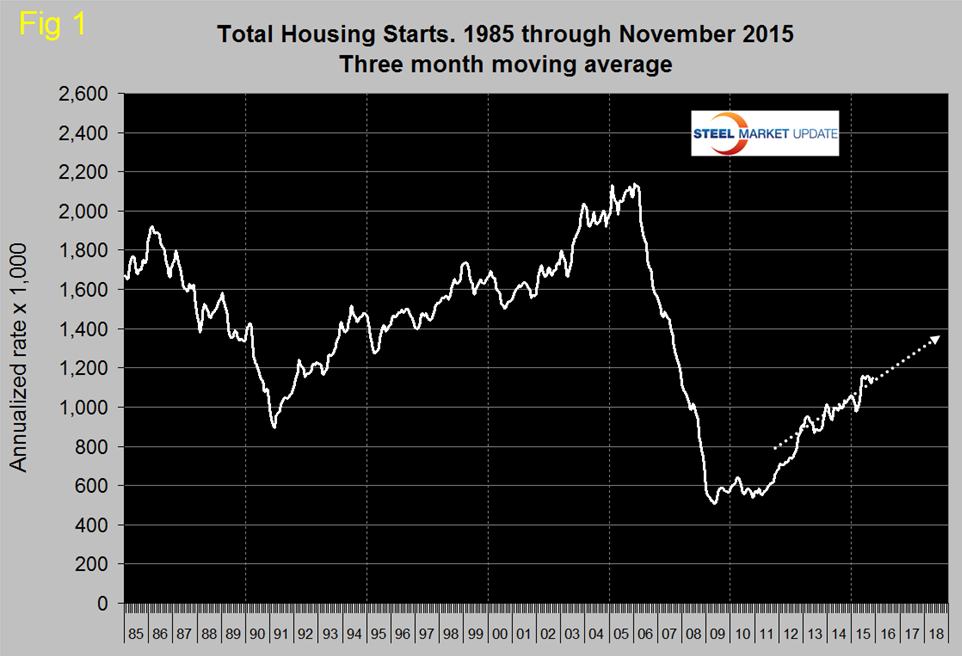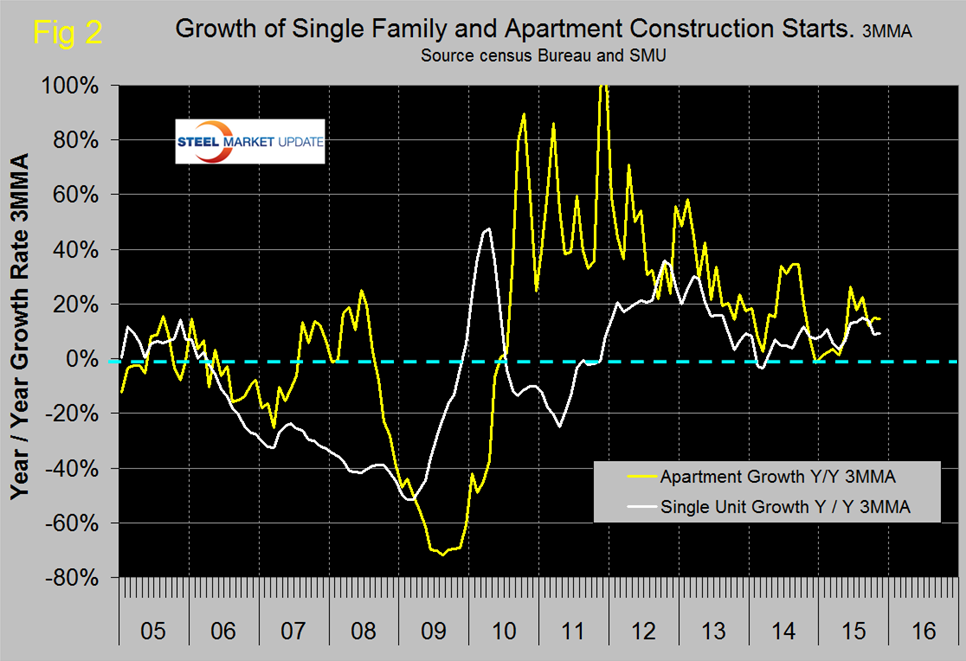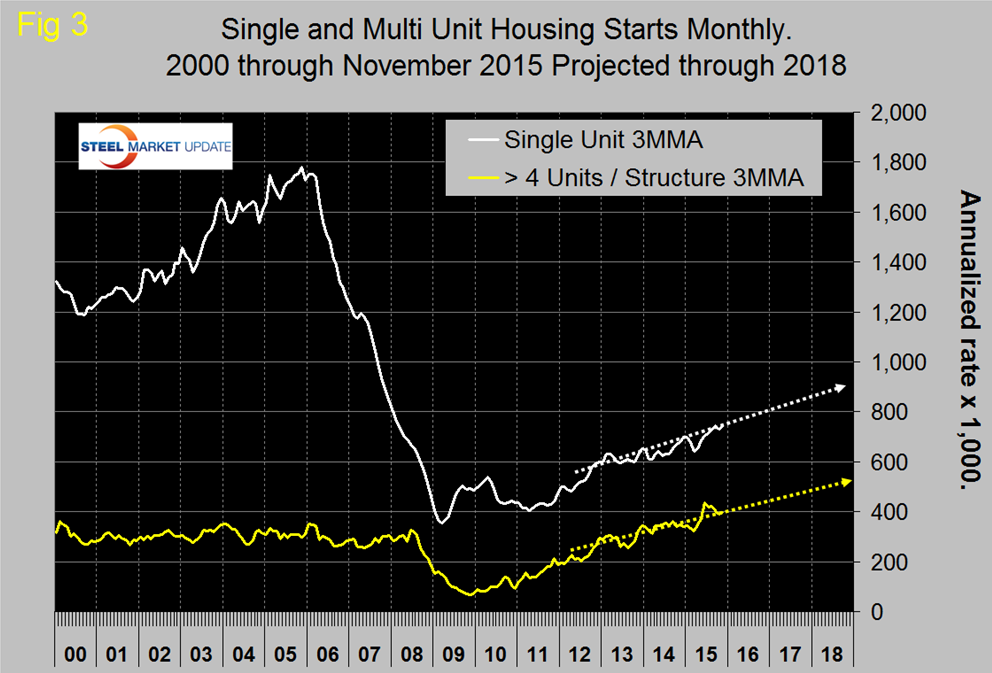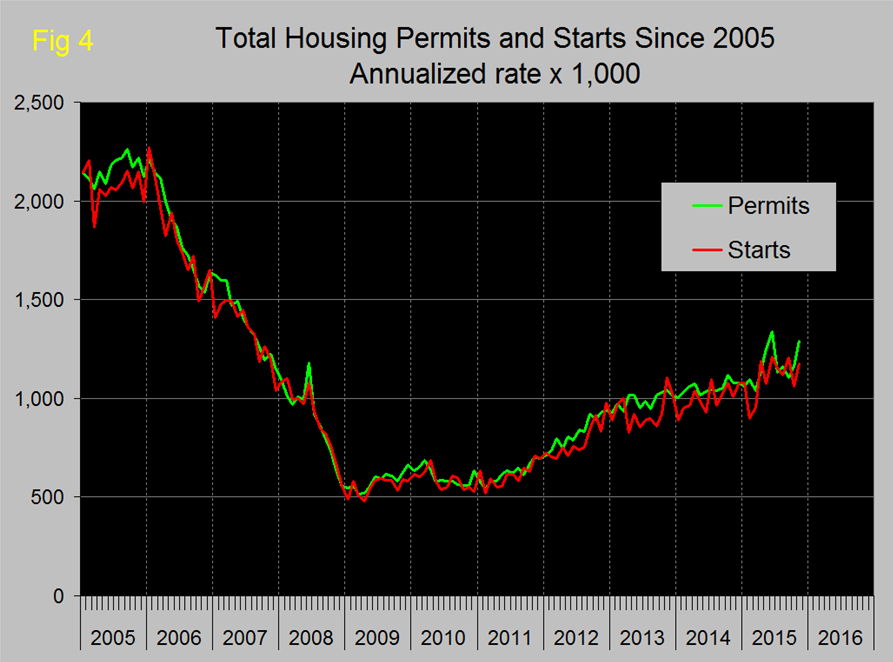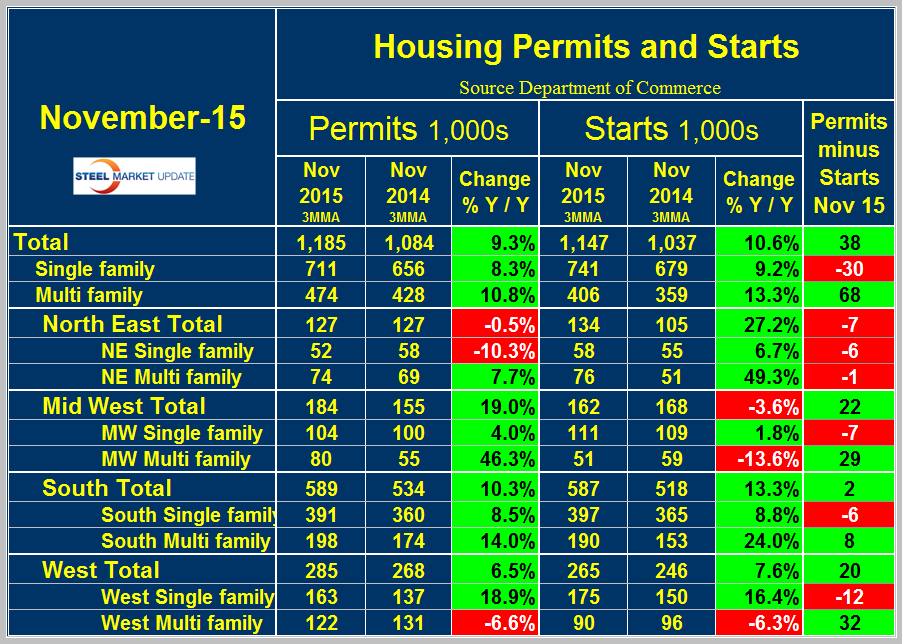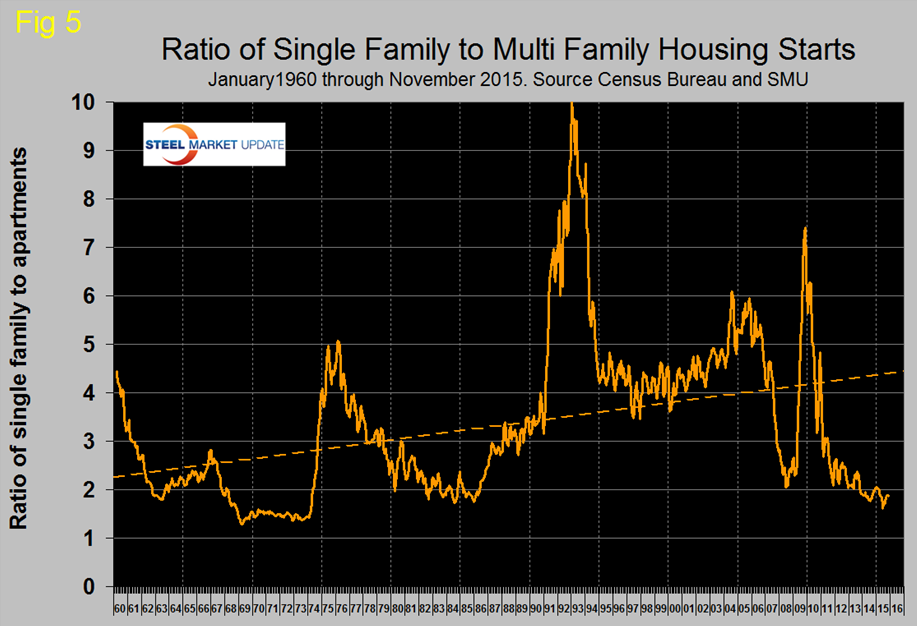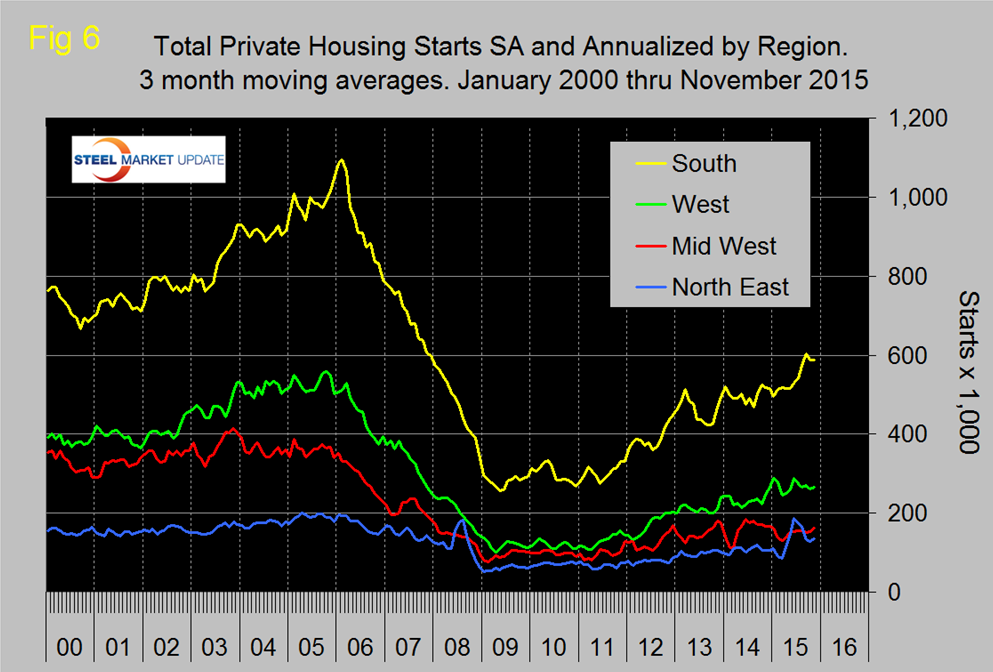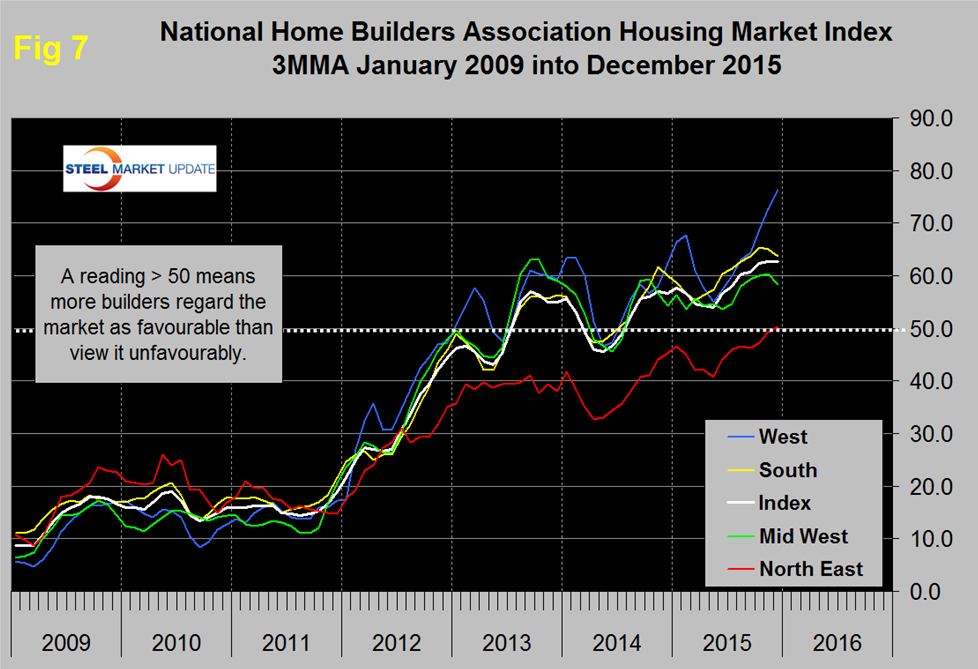Steel Markets

Housing Starts, Permits and Builder Confidence
Written by Peter Wright
December 18, 2015
Total housing starts in November were at an annual rate of 1,173,000 which was up from 1,062,000 in October. Since April total monthly starts annualized have ranged from 1,062,000 to 1,211,000 with the high month being June. In November the three month moving average (3MMA) was 1,147,000 which was up from 1,128,000 in October. August at 1,160,000 had the highest 3MMA since the recession. Total starts are on track to reach 1.4 million units annualized by the end of 2018 (Figure 1).
Single family starts in November were at an annual rate of 768,000 with a 3MMA of 741,000. The 3MMA was up by 9.2 percent year over year but is still 57.9 percent below the peak of late 2005. Multifamily (apartments/condominiums) starts in November were at an annual rate of 405,000 with a 3MMA of 406,000, up 13.3 percent y/y (Figure 2).
The Census Department results are seasonally adjusted and the monthly numbers are annualized. Multifamily starts had lack-luster growth for seven months prior to June and after a three month surge are now back to what is probably a more sustainable level. The trajectory of single family and apartments > 4 units are tracking to reach 900,000 and 500,000 by the end of 2018 respectively (Figure 3).
Permit data is considered to be a leading indicator for starts. If permits exceed starts then there should be an acceleration in construction and vice versa. Total permits in November were at an annual rate of 1,289,000 with a 3MMA of 1,185,000. For the second time this year, permits are well ahead of starts (Figure 4), however it looks as though permits don’t always lead to ground breaking and sometimes, as in 2013 there can be quite a wide divergence.
It also looks from Figure 4 that permits don’t really lead starts suggesting that the two are very close together from a timing point of view. On a 3MMA basis total permits were up by 9.3 percent y/y. Single family were up by 8.3 percent and multifamily by 10.8 percent. Multifamily permit growth peaked at 41.4 percent y/y in July. Most economists have been expecting a decline driven by the end of a tax subsidy in New York State and this can be seen in the data, where permits in the North East fell from 288,000 in May to 131,000 in November.
Table 1 shows total permits and starts nationally and regionally.
At the national level the differential between permits and starts for single and multi-family units is suggesting that the shift in consumer’s preference towards apartments is ongoing. In November on a 3MMA basis, permits of multi-family exceeded starts by 68,000 in contrast to the negative 30,000 for single family. In total permits were 38,000 more than starts. In the recent past the differential between permits and starts for multi and single family units has been the same across all regions but this is no longer the case. In the NE permits declined for both single and multi-family and were less than starts for both. Permits and starts for both single and multi-family had positive growth y/y in the South and North East. Multi-family had negative y/y growth in both the West and Mid West whereas single family had positive growth in both those regions. In all regions permits for single family were less than starts. The implication is that the shift in preference for apartments is by no means over and that single family construction will slow slightly. The ratio of the two sectors is shown in Figure 5 and demonstrates that single family homes continue to be less desirable than at any time since 1985.
Figure 6 shows the regional situation for the 3MMA of total residential starts since February 2000.
In the first half of 2015 the North East had the highest growth rate driven as mentioned above by apartment construction in New York state but now that has cooled. The South has had the most consistent growth this year.
On October 30th Dodge published their forecast for 2016 which included the following comments on housing:
• Single family housing will rise 20 percent in dollars, corresponding to a 17 percent increase in units to 805,000 (Dodge basis). Access to home mortgage loans is improving, and some of the caution exercised by potential homebuyers will ease with continued employment growth.
• Multifamily housing will increase 7 percent in dollars and 5 percent in units to 480,000, slower than the gains in 2015 but still growth. Low vacancies, rising rents, and the demand for apartments from millennials will encourage more development.
The National Association of Home Builders (NAHB) confidence report was released on Tuesday. Any value above 50 indicates an overall positive business confidence. The national average dropped one point in December and is now four points lower than October which had the highest confidence level since our data stream began in January 2009. On a 3MMA basis, November and December had the highest readings both at 62.7 (Figure 7).
The South and West continue to be the strongest regions and the NE has finally reached 50.
The official release from the NAHB was as follows:
Builder Confidence Edges Down One Point in December
Builder confidence in the market for newly constructed single-family homes remained relatively flat in December, dropping one point to 61 on the National Association of Home Builders/Wells Fargo Housing Market Index (HMI).
“Overall, builders are optimistic about the housing market, although they are reporting concerns with the high price of lots and labor,” said NAHB Chairman Tom Woods, a home builder from Blue Springs, Mo.
“For the past seven months, builder confidence levels have averaged in the low 60s, which is in line with a gradual, consistent recovery,” said NAHB Chief Economist David Crowe. “With job creation, economic growth and growing household formations, we anticipate the housing market to continue to pick up traction as we head into 2016.”
Derived from a monthly survey that NAHB has been conducting for 30 years, the NAHB/Wells Fargo Housing Market Index gauges builder perceptions of current single-family home sales and sales expectations for the next six months as “good,” “fair” or “poor.” The survey also asks builders to rate traffic of prospective buyers as “high to very high,” “average” or “low to very low.” Scores for each component are then used to calculate a seasonally adjusted index where any number over 50 indicates that more builders view conditions as good than poor.
All three HMI components posted modest losses in December. The index measuring sales expectations in the next six months fell two points to 67, the component gauging current sales conditions decreased one point to 66, and the index charting buyer traffic dropped two points to 46.
Looking at the three-month moving averages for regional HMI scores, the West increased three points to 76 while the Northeast rose a single point to 50. Meanwhile the Midwest dropped two points to 58 and the South fell one point to 64.
Editor’s Note: The NAHB/Wells Fargo Housing Market Index is strictly the product of NAHB Economics, and is not seen or influenced by any outside party prior to being released to the public.

Peter Wright
Read more from Peter WrightLatest in Steel Markets

USW cheers Evraz NA agreement with Atlas Holdings
The United Steelworkers (USW) labor union celebrated recent news of the signed agreement between Atlas Holdings and Evraz NA in which the Connecticut-based private equity company said it plans to acquire North America’s Evraz facilities.

Steel buyer spirits tempered by soft spot market conditions
Steel sheet buyers report feeling bogged down by the ongoing stresses of stagnant demand, news fatigue, tariff negotiations or implementation timelines, and persistent macroeconomic uncertainty.

Hot-rolled coil buyers continue seeking certainty
Steel market participants contend that buyers will remain in “wait-and-see" mode until some market stability is restored.

Latin American steel advocates warn on cheap import flood
Subsidized Chinese steel imports and cheap steel products from Association of Southeast Asian Nations (ASEAN) entering Latin American (LATAM) are threatening the region's steel market.

CRU: Steel prices fall amid global demand weakness
The forceful headwinds bearing down on steel markets across the globe have created demand challenges and sent prices southward. The US, however, challenged the global trend.

